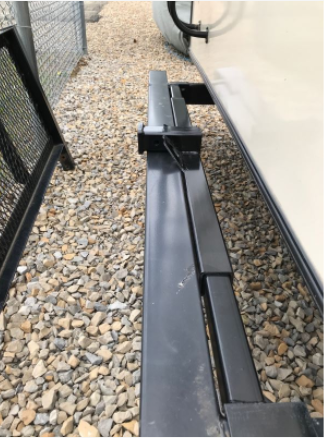No good turn goes unpunished. Removing the battery to save weight on the tongue led me to completely revise the electrical system.
The battery that came with the trailer was a simple lead-acid deep-cycle battery. The problem with these older batteries is that they out-gas hydrogen gas, which can explode, when they are charging so you really don't want them inside the trailer. They are also much heavier and bigger than newer Lithium Iron Phosphate (LiFePo) batteries. But lithium batteries can be dangerous if they are not respected and handled correctly. Lithium burns when exposed to air. Lithium battery makers seal the cells in a package in a vacuum. If you damage that seal, you can expose the cells to air which will cause the lithium to ignite and burst into flames. Don't get me wrong, most of us carry around a lithium battery in our pocket all day without issue. It's called a cell phone.
Designing a power system for our trailer would require care and good workmanship. The basic design would require the batteries and cables to connect them. Then some way to charge those batteries with the special requirements of lithium. Then a way to distribute the power to all the devices in the trailer. I would need a DC to AC converter or inverter to convert the battery power to AC power like we use at home. Then a management system to monitor the batteries and their output. That sounds like a lot of work. Because I am basically lazy, I decided to let someone else do it all for me.
I bought a "Powerstation." The one I got is made by a company called Bluetti (Blue T). It is a box with a built-in battery, charger, monitoring system, circuit breakers, 12v DC output, 110v AC output and is ready to be charged by solar when desired with a built-in solar charge controller. There are many models with different capacities. The Aliner claims, with a sticker on the outside, that it is solar ready but that simply means it has a connector on the outside that goes nowhere. It is very much not ready for solar charging. I positioned the Bluetti over the axle to keep the weight balanced.
Now that I had all the electronics in one box, I could figure out how to distribute the power. I already had the old distribution system that I could modify, so I did not have to rewire the whole trailer.
In opening up the distribution system under the bed, I found a rats nest of wire nuts. House wiring commonly uses these little plastic caps to join two wires together. But houses use solid copper wire. It is very stiff and the wire nuts have little metal blades inside that cut into the two wires being joined to mechanically connect them.
But the trailer uses stranded wire, because everything is flexing all the time. Wire nuts are not my idea of a good way to make connections with stranded wire. I proceeded to trace out and document how the wiring was connected. Then I changed the connection system to use terminal blocks. Then each wire has a place on the terminal block, neat and clean. Each wire has a connector crimped on and then the connector is screwed into the terminal block. It is easier to troubleshoot and more secure.
Our Expedition came with a power center, which is a combination of an AC breaker panel, where the power comes in from outside the trailer and then goes through a main breaker, and then the power is distributed to the outlets in the trailer through individual breakers for different circuits like the microwave and refrigerator.
One breaker supplies power to a DC power supply that produces 12vdc to charge the lead acid battery, the lights and other devices that run off 12vdc.
The output of the DC power supply goes through a fuse panel which connects to all the DC devices. The purpose of the AC breakers and the DC fuses is to protect the wires going to all the devices such that, if a device fails and tries to pull excessive power that could start a fire, the breaker or fuse breaks the circuit saving the wire and cutting off power to the failed device.
I decided to use the old power distribution system to save myself having to rewire the whole trailer. First, I found the circuit breaker going to the DC power supply, and with all the power off, of course, I removed the DC power supply. I did not need it because the Bluetti was now going to supply power to the DC devices and the Bluetti has its own battery..
I simply noted the wire coming out of the DC power supply that feeds the fuse panel and ran a new wire from the Bluetti DC output to replace the DC power supply feed.
Next, in order to use the old AC distribution system, I added a new main breaker box with a main breaker in it to feed one outlet. That outlet would charge the Bluetti and supply pass-through AC, which allows the Bluetti to pass AC through itself directly to AC devices plugged into it when it is connected to outside AC. No battery power used. Then I ran a new wire from the Bluetti AC outlets to the old AC distribution panel into the old main breaker. Now all the AC outlets in the trailer would be powered by the Bluetti AC output.
Since the Bluetti is capable of being charged by solar panels, because it has a built in solar charge controller, my next project will be to wire the solar panel socket on the outside of the trailer to the Bluetti.
All of this series of mods just because I wanted a bike rack on the back of the trailer :-)



































